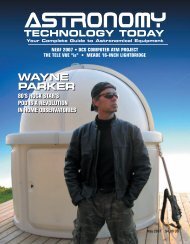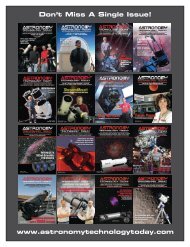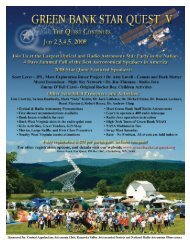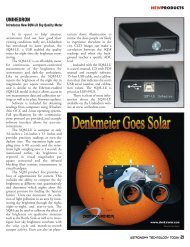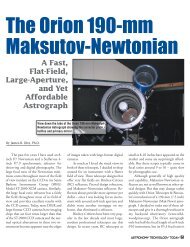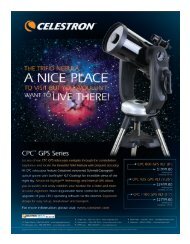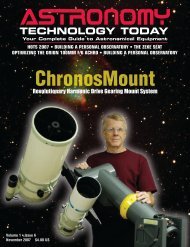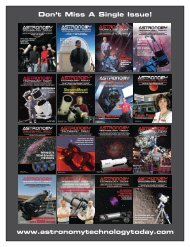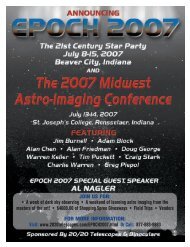iOPTRON - Astronomy Technology Today
iOPTRON - Astronomy Technology Today
iOPTRON - Astronomy Technology Today
You also want an ePaper? Increase the reach of your titles
YUMPU automatically turns print PDFs into web optimized ePapers that Google loves.
M-Uno: A<br />
Image 1 - The M-Uno at WSP 2013.<br />
Pier-less<br />
Mount Armed and Amazing<br />
By Theodore Saker<br />
A solid mount is as essential for astrophotography<br />
as fine optics and a capable<br />
camera. There’s no getting around it. The<br />
most meticulously made optics and the<br />
best camera will not produce good images<br />
if placed on a mount that cannot track a<br />
target object accurately. Choosing the right<br />
mount for astrophotography can be a<br />
major technical and budgetary challenge.<br />
Avalon Instrument’s M-Uno is a radical,<br />
if not revolutionary, advancement in<br />
design and construction of the modern<br />
equatorial mount within the reach of serious<br />
astrophotographers. The M-Uno is a<br />
compact, portable mount designed to enable<br />
high-quality astronomical imaging<br />
without many of the drawbacks of other<br />
mount designs. I was fortunate enough to<br />
attend the 2013 Winter Star Party, and<br />
being given the opportunity to examine<br />
and use the M-Uno at that event was an exceptional<br />
bonus.<br />
To grasp the extent of Avalon’s accomplishment,<br />
a description of the current state<br />
of the art is helpful to show just how distinct<br />
the M-Uno is when compared to similar<br />
mounts in its class. Every mount<br />
design, like optics, represents a compromise<br />
of one kind or another. The ultimate<br />
goal is for the image to contain round stars,<br />
an indication of good tracking and of a<br />
mount that performs to the best of its design<br />
and construction standards. Astro-imagers<br />
have long relied upon equatorial<br />
mounts as mainstays for imaging. Equatorial<br />
mounts track an object with only one<br />
rotational axis, thereby greatly enhancing<br />
tracking accuracy.<br />
Serious astro-imagers rely on the German<br />
Equatorial Mount (GEM). The German<br />
Equatorial design dates to the early<br />
19th Century and is credited to Joseph<br />
Fraunhoefer, the Bavarian who discovered<br />
absorption lines in sunlight and cast the<br />
first true optical glass. It is a classic design<br />
whose chief advantage is its ability to track<br />
objects using one rotational axis and with<br />
the weight of the mount and payload perpendicular<br />
to the ground.<br />
Although serious astroimagers rely<br />
chiefly on the GEM, it has a number of significant<br />
drawbacks. The first is known as<br />
the “meridian-” or “pier-flip.” When the<br />
telescope is pointing east, the telescope is<br />
on the west side of the mount. As the object<br />
ascends towards the meridian, the telescope<br />
and payload get closer and closer to<br />
the GEM’s body. When the object reaches<br />
the meridian, the telescope must be<br />
“flipped” to the other (east) side of the<br />
mount in order to track the object west of<br />
the meridian. After the pier flip, the user<br />
has to reacquire the object on the camera<br />
chip’s field of view. It may be difficult or<br />
impossible to find a suitably-bright guide<br />
star. The user loses the opportunity to<br />
image objects when they are located in a<br />
prime place in the sky.<br />
Another disadvantage with the GEM<br />
is the necessity of placing counterweights<br />
of similar weight opposite the payload. The<br />
counterweights may require adjustment to<br />
improve the mount’s tracking ability after a<br />
pier flip.<br />
Most astro-imagers shrug their shoulders<br />
and deal with the GEM’s drawbacks,<br />
concluding that its advantages outweigh<br />
the disadvantages. When compared to<br />
other prevalent designs, the GEM holds<br />
the advantage.<br />
Some astro-imagers use fork mounts<br />
to avoid the pier-flip problem. In order to<br />
use one rotational motor, the fork mount<br />
usually is placed on an equatorial wedge to<br />
align the right-ascension (RA) axis with the<br />
Earth’s axis and utilize only one motor to<br />
track objects. The chief problem with a<br />
fork-mounted telescope is its inherent instability.<br />
When placed on a wedge, the<br />
weight of the mount and payload is unevenly<br />
distributed on the tripod. To combat<br />
this problem, a fork mount requires a<br />
heavy base and beefier fork arms to support<br />
<strong>Astronomy</strong> TECHNOLOGY TODAY 43



